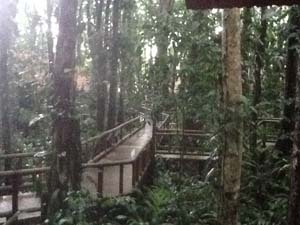Sports, science, and SciLinks
By Mary Bigelow
Posted on 2012-07-31
 Perhaps our students don’t think so, but it’s unfortunate that the summer Olympics happen when most of the schools here in the U.S. are on break. There are many ways to show the connections between science concepts and sports that will have to wait until classes resume.
Perhaps our students don’t think so, but it’s unfortunate that the summer Olympics happen when most of the schools here in the U.S. are on break. There are many ways to show the connections between science concepts and sports that will have to wait until classes resume.
As described in a previous NSTA blog, Science of the Summer Olympics has resources to help you students understand the science behind sports.
There are other topics in the series, which includes related lesson plan ideas:
NSTA’s SciLinks database has reviewed websites on topics related to sports and athletics:
- Health Benefits of Sports (5-8 and 9-12)
- Energy and Sports (5-8 and 9-12)
- Sports and Conditioning (5-8)
One of my favorites on the topic is Sport Science from the Exploratorium. Let the Games begin!
Photo: http://www.flickr.com/photos/jeremywilburn/2859958331/
 Perhaps our students don’t think so, but it’s unfortunate that the summer Olympics happen when most of the schools here in the U.S. are on break. There are many ways to show the connections between science concepts and sports that will have to wait until classes resume.
Perhaps our students don’t think so, but it’s unfortunate that the summer Olympics happen when most of the schools here in the U.S. are on break. There are many ways to show the connections between science concepts and sports that will have to wait until classes resume.
Science of the Summer Olympics: Missy Franklin & fluid dynamics
By admin
Posted on 2012-07-30
 Let the Games begin!
Let the Games begin!
NSTA has teamed up once again with NBC Learn and the National Science Foundation (NSF) to bring you another exhilarating video series with connected lesson plans that will excite your students and add to your hands-on repertoire. Science of the Summer Olympics consists of 10 learning packages that will bring life to your STEM efforts.
The Science of… series has become a hit. Exciting live action coupled with explanations of the science behind it gives teachers a tool that piques student interest. Science of the Summer Olympics focuses on the link between science knowledge and engineering design with input from NSF engineers helping your students see how science is put to work. Then NSTA-developed lesson plans complete the packages. The series is available cost-free on www.NBCLearn.com and www.NSF.gov.
NSTA will also post portions of each package in this blog over the next several weeks, under the “NSF Videos and Lessons” category, and we hope you will try them out in the classroom. If you do, please leave comments below each posting about how well the information worked in real-world classrooms. And if you had to make significant changes to a lesson, we’d love to see what you did differently, as well as why you made the changes. Leave a comment, and we’ll get in touch with you with submission information.
–Judy Elgin Jensen
Photo of giant Olympic rings by Government Olympic Communications.
Video: In “Missy Franklin & Fluid Dynamics,” Timothy Wei, Dean of the College of Engineering at the University of Nebraska, Lincoln, applies concepts of fluid dynamics to “engineering” elite swimmers’ strokes, such as Olympic swimmer Missy Franklin’s, in much the same way as engineers design cars and airplanes to move through the fluid atmosphere.
Lesson plans
Two versions of the lesson plans help students build background and develop questions they can explore regarding the actions of objects in fluids. Both includes strategies to support students in their own quest for answers and strategies for a more focused approach that helps all students participate in hands-on inquiry.
SOTSO: Missy Franklin & Fluid Dynamics models how students might investigate factors that impact movement of objects through fluids.
SOTSO: Missy Franklin & Fluid Dynamics An Engineering Perspective models how students might apply what they learn in the video or other sources about fluids and motion to designing objects that move more efficiently in fluids.
You can use the following form to e-mail us edited versions of the lesson plans:
[contact-form 2 “ChemNow]
 Let the Games begin!
Let the Games begin!
NSTA has teamed up once again with NBC Learn and the National Science Foundation (NSF) to bring you another exhilarating video series with connected lesson plans that will excite your students and add to your hands-on repertoire. Science of the Summer Olympics consists of 10 learning packages that will bring life to your STEM efforts.
NSTA Professional Development Trip: Part IV
By Lauren Jonas, NSTA Assistant Executive Director
Posted on 2012-07-28
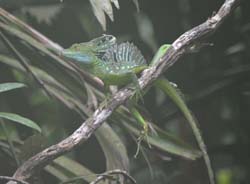 Exploring the Canals around Tortuguera
Exploring the Canals around Tortuguera
NSTA Costa Rica Trip Day 3
July 26, 2012
(posted on behalf of Greg Neff)
We departed Evergreen lodge at 8:30 am in a boat to explore the canals connecting three rivers in the Tortuguero area. Took a 2 1/2 hour trip through the canals. We observed and identified 31 different species of flora and fauna on this tour.
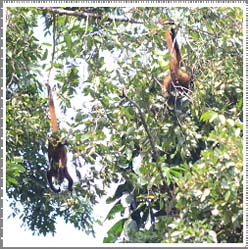 As mentioned on an earlier posting, the lumber company built the canals to access a greater amount of the commercially viable trees. However, trees had to be floated in rafts down the canal to the coast where they could be processed and shipped. The Almendro tree, avery dense and massive tree with excellent wood, was not harvested because it would not float. This was very beneficial to the area because these almendro trees are an ecosystem in themselves. They host massive amounts of vines, bromeliads, orchids, reptiles, and birds. Most notable is the Great Green Macaw, 90% of which nest in almendro trees. The fruit of the almendro also is a major part of their diet.
As mentioned on an earlier posting, the lumber company built the canals to access a greater amount of the commercially viable trees. However, trees had to be floated in rafts down the canal to the coast where they could be processed and shipped. The Almendro tree, avery dense and massive tree with excellent wood, was not harvested because it would not float. This was very beneficial to the area because these almendro trees are an ecosystem in themselves. They host massive amounts of vines, bromeliads, orchids, reptiles, and birds. Most notable is the Great Green Macaw, 90% of which nest in almendro trees. The fruit of the almendro also is a major part of their diet.
Almendro trees in other areas of CR that are more accessible have been harvested, and this has devastated the Green Macaw population of CR. It is estimated that there are approximately 200 Green Macaws remaining in CR. The macaw has a distinctive raucous call that can be heard a long distance away. We heard them coming then observed a group of 7, then moments later a pair, flying high overhead.
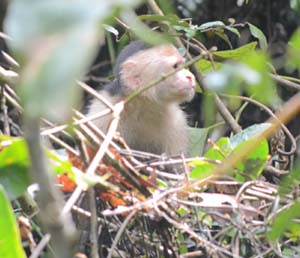 Encountered a family of white faced monkeys, pulled the boat under some trees and soon were within reach of at least 4 juveniles. Acting oblivious to our presence, these monkeys climbed the bushes next to us and about 1 meter overhead. The white faced monkey, better known as the Capuchin monkey, is omnivorous, eating insects, small animals, fruit, and nuts. They travel great distances in a day and virtually sweep through the forest as they go. Their diet requires large tracts of land for habitat, thus they are not found in small forested areas. We also observed 2 groups of spider monkeys. Spider monkeys are more specific in their diet and can live in much smaller tracts of land.
Encountered a family of white faced monkeys, pulled the boat under some trees and soon were within reach of at least 4 juveniles. Acting oblivious to our presence, these monkeys climbed the bushes next to us and about 1 meter overhead. The white faced monkey, better known as the Capuchin monkey, is omnivorous, eating insects, small animals, fruit, and nuts. They travel great distances in a day and virtually sweep through the forest as they go. Their diet requires large tracts of land for habitat, thus they are not found in small forested areas. We also observed 2 groups of spider monkeys. Spider monkeys are more specific in their diet and can live in much smaller tracts of land.
Returned to the Evergreen lodge for lunch, then off to visit the elementary school in the village.
NSTA Professional Development Trip: Part III
By Rob McNeely
Posted on 2012-07-27
Night 2
(posted on behalf of Greg Neff)
July 25, 8-12:00 pm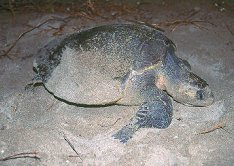
Returned to the research center for the second night shift of monitoring the turtles. It was a beautiful starry night, not a cloud in sight and comfortable temperatures. This is going to be a breeze compared to last night! This time our crew was assigned to the parquet beach which goes south from the research station. The tide was low, an unwelcome sight for the turtles as they prefer high tides as they have less crawling to do on land to reach a suitable nesting area.
Because of the low tide we had a long way to walk before we saw fresh turtle tracks. When we did discover trackside, it was like a highway, with multiple tracks crisscrossing each other. Very confusing to the novice, but the research assistants and our guides were very competent in distinguishing tracks which were fresh and had no return path.

In the earlier sift we discovered one of the challenges of preservation and sustainability. During the hours of 8:00-12:00 local guides are allowed to bring groups of tourists onto the beach to observe the turtle nesting. Groups are restricted to 10 observers or less.
Our first 2 turtles this evening, each had 4 groups waiting to see the turtle. We did our measuring tasks, being celebrities for the tourists. It was an educational experience for us as well as the tourists and a very vivid reminder that protecting and exploitation run a fine line.
We saw several turtles trying to leave the water, but nervous about the activity on land, and observed 2 returning to the sea from the nesting sites. Because of the low tide and no rain conditions, we were able to easily walk to the limits of the beach. Then we turned around and began our return to the research center. In our walk back we found 2 more turtles that were ready to be logged.
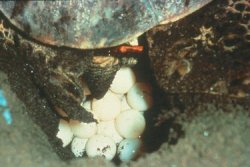
One of these was totally entwined in beach vines. This and being in the later stages of nesting cause this turtle to be more agitated than our previous charges. This turtle was throwing great quantities of sand and rolling around, making the carapace measurement a challenge. After completing the log, we were all covered with sand and sand flies.
Next 15 minutes were very uneventful, but we realized that our shift was almost over and we needed to pick up our pace dramatically in order to be back and allow the second shift to work. Then it happened the lovely stray skies disappeared and the rain immediately became torrential. Barely had time to cover the data collection kit-pack with the poncho! The last 1/2 hour was in this deluge and we had no more turtles to monitor. Half hour wait at the research station for our boat-taxi to come and return us to the Evergreen lodge. Another shower with all adds my clothes on, to remove the sand, but this time I was able to hang it all up and craw into bed by 1:00. 6 whole hours before breakfast and night 2 is done!
Tomorrow we explore the canals around Tortuguera. The canals were built by the lumber companies in order to facilitate access to remote trees and connect the rivers in the area. The lumber company was able to convince the CostaRican government that the canals would be a good idea because it would give the population better access to and from the coast. This was pare-national park days. Today the project would not be allowed as the canals dissect the national park.
Pictures are not allowed on the turtle walk. The turtle images above are from the Sea Turtle Conservancy’s web site http://www.conserveturtles.org
NSTA Professional Development Trip: Part II
By Lauren Jonas, NSTA Assistant Executive Director
Posted on 2012-07-26
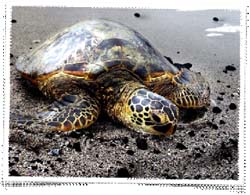 Turtle Data Collection
Turtle Data Collection
(posted on behalf of Greg Neff)
July 24 PM
On a very rainy afternoon, we visited the town of Tortuguero, being sure to equip ourselves with rain gear and take in some of the culture of this isolated community, yet dependent on tourism.
We attended a presentation on the history of the Sea Turtle Conservancy. Interesting program, where the local monitoring of Turtle nesting beaches and data collection is done mainly by college student interns.
Historical presentation was followed up by a 1 1/2 hour training session on how to approach and log nesting turtles. We given instructions off sad how to collect and log the data followed by several practice sessions. Felt well prepared to go and do some turtle research. This would happen in shifts later in the evening
Part of a group that pulled the 12:00-4:00 am shift, 2 groups returned to research center at 11:45. Though we all had rainwear, we were quite unprepared for the deluge we were to experience. The 8-12 shift was returning drenched and coated with black volcanic sand!
Quick review of data collection protocol and we were out on the beach in very dark wet conditions, use of lights for navigation is forbidden so as not to alarm the turtles. We walked the beach watching for turtle tracks, which in the dark, look as if you had tied a log to a rope and dragged it up the beach. The research assistant, explained how to determine weather it was an up beach track or a down beach (to the water) track. You just have to pass your hands in the wet sand and feel for the direction of flipper marks.
Rain continued to come down sporadically in torrents and as a fine mist the entire time. Dark conditions made walking challenging, but the real treachery was in the terrain itself. The beach was littered with coconut, shells, driftwood and fallen trees. These you could sense as you approached them. There were also the body pits dig by turtles to lay their eggs. These were no small obstacle, often being almost 1 meter deep. Often the first indication you were at one of these was when you were plunging into it. Now I know why the first crew was covered in sand!
Finding a turtle in the process of nesting, there are 4 stages as that the turtle goes through:
Leaving the sea and dragging itself up the beach
Digging a body pit large enough to contain its entire body and the egg chamber
Going into a trance, and laying the eggs
Leaving the trance, camouflaging the actual egg site, and returning to the sea
During these stages the only time the turtle is actually workable is during the trance/egg laying stage. We found turtles, 6 of them, but were able to approach only 2 of them. Even in the trance stage, the turtle was throwing around sand, giving measurement a challenge.
Returned to the research center and encountered the other late shift group. They had measured 6 turtles.
Boat ride back to Evergreen lodge, totally wet and caked in sand. Took a shower with all my clothes on to remove the sand. Removed 1 layer at a time. Fell into bed for a 2 hour nap before breakfast time. One night of data collection done, 2 to go!
Day 2

(posted on behalf of Greg Neff)
July 25, 2012
Departed San Jose at 6:30 for Tortuguero, Costa Rica. Traveled main Hwy 32 towards province of Limon.
Drove over the continental divide. East of which rivers flow towards the Caribbean, west rivers flow toward the Pacific.
Most of the first 2 hours took us through the Braulio Carillo National park. The park and highway 32 were both named after the first Costa Rican president, instrumental in establishing Costa Rica as an independent country, and developing communication and access between the central valley and the Caribbean coastal areas.
CR National Park system is modeled after the National Park system of the US, however with some major philosophical management differences.
US park system is designed for the parks to have minimal development and be economically self sustaining units that preserve the natural environment and provide access to the public.
CR has different levels of environmental protection including, wildlife refuge, national forest, and national park. The park, the highest level of protection, is a system primarily intended to preserve the natural environment, and prohibits development beyond the necessary management facilities. Besides preventing construction of hotels and lodges, hunting and resource harvesting are also forbidden. The parks are mainly accessible only at the perimeters, minimizing public as well as tourist use.
The a preservationist approach to managing the parks results in a system economically dependent on government directed funds. CRs current challenge is to balance the economic sustainability with the environmental and global necessity of preserving its unique and precious resources. Even educating its own population.

Left the bus at the parameter of Tortuguero National Park, and began our 1 1/2 hour journey to the coast and the community of Tortuguero. Tortuguero is only accessible by water and is a community/town that was established and developed before the national park was declared. This remains a small area of privately owned land, completely surrounded by the national park.
The Tortuguero National Park is a classic example of the challenges CR faces convincing the national population of the need to rethink traditional methods of resource usage. The sea turtles have traditionally provided food, and have been harvested with sour restriction until the 1970’s. Due to the efforts of Dr. Archie Carr during the 1960’s, the CR government became concerned about the sustainability of the sea turtle population, as the CR coastlines are one of the primary global nesting sites for turtles. The Tortuguero National Park was declared, but it required educating the local population as to the value of such a protection. Locals were first employed in the research and data collection, eventually a tourist industry developed, making live turtles of far greater value to the local population. Poaching and local clandestine use still occurs, however the scale of harvesting has been dramatically reduced, with the local population well aware of the value of preserving this resource.
Next, taking part in the count, data collection on turtle nesting.
NSTA Professional Development Trip to Costa Rica
By Lauren Jonas, NSTA Assistant Executive Director
Posted on 2012-07-26
Sally Ride
By Mary Bigelow
Posted on 2012-07-24
From NSTA Bloggers Peggy Ashbrook and Mary Bigelow:
 Whether we had met her personally or not, the death of astronaut, physicist, and educator Dr. Sally Ride deeply saddened us. Dr. Meg Urry speaks for many women in science when she writes about Dr. Sally Ride, “…thanks to her notoriety as a NASA astronaut, I found out about one more precious role model, someone in whose steps I could hope to follow. (OK, not the astronaut part — I am far too chicken for that.) Ride made success seem attainable, even in the men-only world of physics.” See her full statement here.
Whether we had met her personally or not, the death of astronaut, physicist, and educator Dr. Sally Ride deeply saddened us. Dr. Meg Urry speaks for many women in science when she writes about Dr. Sally Ride, “…thanks to her notoriety as a NASA astronaut, I found out about one more precious role model, someone in whose steps I could hope to follow. (OK, not the astronaut part — I am far too chicken for that.) Ride made success seem attainable, even in the men-only world of physics.” See her full statement here.
I hadn’t realized what Sally Ride’s achievements and life work meant to me until I heard that she died at only 61 and I immediately teared up. Even though I thought, “Of course women can and should,” at the time of her first space mission, it was Dr. Ride’s accomplished example that confirmed this. – Peggy Ashbrook
First and foremost, we remember her as an astronaut. Listen to Sally Ride describe her shuttle missions and NASA’s statement on her passing.
Sally’s first mission took place after school was out for the summer (June 18, 1983). But for her next mission in October 1984, my colleagues and I had the television on to watch with our students when two women astronauts were part of the team. The look on the girls’ faces (and mine) was priceless. – Mary Bigelow
Having role models is not enough to empower girls to pursue their interest in science. Dr. Ride established a company (Sally Ride Science) to support girls’ (and boys’) interest in science and to educate teachers.
Thank you, Sally Ride, for continuing to inspire and support girls and women in science during your career as an astronaut, physicist, and educator. Your leadership and example will be missed.
Links from the Sally Ride Science site:
Contributions of 20th-Century Women to Physics — An archive presenting and documenting some important and original contributions made before 1976 by 20th century women.
Role Model Project for Girls — A resource center for collaborative work among women’s groups, inquisitive feminists, women activists, and others.
The Archives of Women in Science and Engineering — The Archives of Women in Science and Engineering seeks to preserve the historical heritage of American women in science and engineering.
Note: The second woman on the 1984 STS-41G mission was Kathryn D. Sullivan.
Photos: NASA
From NSTA Bloggers Peggy Ashbrook and Mary Bigelow:
Students as part of school leadership for promoting reforms in science
By Robert Yager
Posted on 2012-07-22
–Occasional commentary by Robert E. Yager (NSTA President, 1982-1983)
 Connecting Learning Assures Successful Students (CLASS) is a Professional Development (PD) effort for teachers operating throughout Indiana and several other States, including Iowa. One of the innovations tried was the use of students as part of school leadership teams; students at varying grade levels were called “Ambassadors,” and they met regularly with teachers and administrators to establish rules, work on problem resolutions, and outline efforts to improve learning in the school. The work began in elementary schools where principals and a set of elementary teachers conceived the power of student views and voices which could improve the school and enhance student learning for all. Student leaders were to work with CLASS teachers, school administrators, and parents to illustrate this new and important addition to “Distributed Leadership”.
Connecting Learning Assures Successful Students (CLASS) is a Professional Development (PD) effort for teachers operating throughout Indiana and several other States, including Iowa. One of the innovations tried was the use of students as part of school leadership teams; students at varying grade levels were called “Ambassadors,” and they met regularly with teachers and administrators to establish rules, work on problem resolutions, and outline efforts to improve learning in the school. The work began in elementary schools where principals and a set of elementary teachers conceived the power of student views and voices which could improve the school and enhance student learning for all. Student leaders were to work with CLASS teachers, school administrators, and parents to illustrate this new and important addition to “Distributed Leadership”.
Specific CLASS efforts have been tied to Iowa Chautauqua PD efforts. These have focused on success of school principals as critical players in accomplishing school reforms. The plan to include students as part of school leadership was added to the idea of “Distributed Leadership” with several specific PD efforts in Iowa. The Student Ambassadors in the Iowa Chautauqua arose from teacher needs to make all students more central to science projects—both individual and group efforts. Students were invited to be part of the leadership planned for schools where teachers have worked as collaborators with the Iowa Chautauqua learning teams for over three decades. Results in several Chautauqua sites have been most positive!
Great advantages can be observed when school principals are major partners in accomplishing the reform efforts. Significantly more successes have been continually observed when the ideas were tried in schools where principals were important and active partners. Many principals were quick to support the idea of adding students to leadership teams. In the Chautauqua Leadership Conferences each summer the Iowa Chautauqua PD Leadership was enlarged to include the involvement of teachers, administrators, counselors, school board members, and students selected in a few specific middle schools (Grades 6-8) in Iowa.
One of the earliest schools involved with Iowa Chautauqua was most successful in getting all science teachers involved with other teachers across all the disciplines comprising curriculum. The teacher team worked with a specific group of students and used projects and issues that became the organizers for learning. They were not tied to each major discipline for typical 50 minute class sessions each day. The principals of three middle level schools were impressed with the results when told of the CLASS Student Ambassador program. They were interested in the specific results and wanted to see what could happen in their buildings. The teachers were already on board and knew of the features that define constructivist learning. The most impressive aspect was involving students first in all aspects of learning; students, teachers, and administrators were ready to try the CLASS Student Ambassador effort!
When the Ambassador program was tried successfully in Iowa with middle level students, results were collected by graduate student assistants. Results from one year included: 1) over half of the students reported science as being their most interesting class; 2) 70% of the grades 6-8 students reported that the Ambassadors performed as needed “partners”; 3) 60% of the students liked that Ambassadors worked together across the grade levels and sought out examples from other Ambassadors; 4) 60% were anxious to help students in other schools and share the advantages of student leadership; 5) more were anxious to add their own personal views after the Ambassador Program had been tried and used.
All principals involved with the inclusion of students in the school leadership were excited; they were anxious to share the experiences with others. All teachers were positive about the effectiveness of having Student Ambassadors as part of school leadership. They noted that the whole school and in many instances the whole community benefited. Learning was enhanced!
–Robert E. Yager
Professor of Science education
University of Iowa
Image courtesy of Eugena Ossi/Governor Deval Patrick’s Office.
–Occasional commentary by Robert E. Yager (NSTA President, 1982-1983)
Mobile Technology
By Christine Royce
Posted on 2012-07-18
It is interesting teaching at the college level – the common phrase of “put your cell phones away during class” is still heard regularly. I actually have one colleague who will confiscate the cell phone until the end of class and then return it – yes a college class. While I don’t particularly want students texting from class to their friends about their weekend plans, I do believe that smart phones or tablets can have a place in class. We have one faculty member who is experimenting with having students enrolled in a Developmental Reading class “tweeting” this summer. Who knows how it will work, but it seems to be engaging the students outside of class time by responding to other tweets. Why this is more engaging then posting to a discussion board – I am not sure – but it seems to be.
One program I have recently found relates to using mobile devices as personal response systems – socrative – allows the teacher to set up a “classroom” that allows up to 50 participants at once each using their own mobile device to respond – including open ended responses such as exit slips. I am planning on trying this during the upcoming semester with a methods class – and would love to hear about any other people’s experiences using this or other programs such as this.
How do you bring mobile technology into your classroom????
It is interesting teaching at the college level – the common phrase of “put your cell phones away during class” is still heard regularly. I actually have one colleague who will confiscate the cell phone until the end of class and then return it – yes a college class. While I don’t particularly want students texting from class to their friends about their weekend plans, I do believe that smart phones or tablets can have a place in class. We have one faculty member who is experimenting with having students enrolled in a Developmental Reading class “tweet
Beginning the school year with goals
By Peggy Ashbrook
Posted on 2012-07-18
Early in the month of August, pre-kindergarten teacher Gail Laubenthal begins planning for the young children who will soon be entering her classroom. As a guest blogger she is sharing her ideas on how to start the school year by setting goals for herself and her children. Gail teaches pre-kindergarten at Sanchez Elementary School in the Austin Independent School District in Austin, TX. In the coming year she will communicate with families and other teachers on her Laubenthal’s Ladybugs website and a classroom blog which will highlight classroom activities.
Peggy
Gail Laubenthal writes:
My goals began with this one for science vocabulary and language development:
By the end of the school year, my children will be able to look at a variety of materials from their environment and use descriptive language to describe the materials’ differences and/or similarities. In the fall, I will ask the children to sort objects into groups that are alike and see if they can tell me why they sorted them in that manner. The results of this task will be useful and will guide my teaching for the rest of the school year.
The May 2011 draft of the Next Generation Science Standards (NGSS) for Physical Science states that by the end of second grade (Grade Band Endpoints for PS1.A) students will understand that there are “different kinds of matter (e.g., wood, metal, water), and many of them can be either solid or liquid, depending on temperature. Matter can be described and classified by its observable properties (e.g., visual, aural, textural), by it uses, and by whether it occurs naturally or is manufactured.”
I had the children use their senses to explore and then verbally describe “matter” in their environment by “Exploring with Magnets” and “Exploring with Our Senses”. In the draft NGSS, investigating patterns in the forces between two magnets is for grades above the early childhood years. However, the statement “builds on K-2 experiences” is part of every standard above early childhood so it is appropriate for children to do some work with magnets.
Exploring with Magnets
At the very beginning of the school year I put magnets in the Science Center.
- Children are amazed that they can pick up other objects or move objects around without even touching the object. There was lively interest for weeks for going on Magnet Hunts to test for attraction.
- Wonderfully rich vocabulary words can be used while exploring magnets: alike, same, different, compare, sort, group, magnet, attract, repel, magnetic, nonmagnetic, predict, graph, and count. Children began to use these words to describe their experiences and later were observed making connections to these early explorations when given other materials to investigate. For instance, when they realized that some of the rocks (lodestone and hematite) in a basket of assorted rocks and minerals were magnetic, they began testing other rocks to see if they were “attracted” to metal things.
Exploring with our Senses
In September, we began purposefully using our senses to explore our environment.
- Our eyes focused on the shapes of objects, like doors, tables, windows, swing set poles, slides, sidewalks, ceiling tiles, balls and classroom materials and equipment. We played “I-Spy” with our eyes, both indoors and outdoors.
- But with our hands, we really began to compare and contrast items, using only our sense of touch at first by describing something in a mystery bag. Later, we used all of our senses and that’s when the descriptive language began to grow.
Gathering Data:
 In October I gave the children the initial sorting task with a tray of objects to sort or group things that might go together—things that are alike. I recorded their observations and used them as data for planning science explorations for the rest of the year.
In October I gave the children the initial sorting task with a tray of objects to sort or group things that might go together—things that are alike. I recorded their observations and used them as data for planning science explorations for the rest of the year.
During the school year I planned experiences to encourage the children to increase their ability to examine, compare, contrast, and discuss the properties of objects in their environment. They continued to use their senses as they learned about food they ate, toys they played with, and animals and plants, both in and out of the classroom.
Using letter and word walls, thematic word banks, non-fiction and fiction books, local experts, field trips, and hands-on materials, ensured that the science topics were fully developed and integrated across the curriculum. For instance, we used a word web to record everything that the children already knew about pumpkins, and then continued to add onto it as they discovered and learned more. Some of the experiences were guided, but many of them were independently carried out with other children. I kept a notebook handy to record their conversations, wonderings, and “Ah-ha” discoveries, as well as a camera ready to film (both still and video) their experiences.
Final Properties of Matter Activity and Assessment:
 As a culminating activity in our rock and fossil unit of study in April, I set up pairs of rocks for the children to compare by color, luster, weight, texture, and patterns. In small group discussion, the children used the descriptive language that we had been using all year in the previous compare and contrast activities as they examined the pairs of rocks with loupes, hand lenses, a SmartScope digital microscope (and laptop for viewing). The children described the differences, similarities, and additional properties.
As a culminating activity in our rock and fossil unit of study in April, I set up pairs of rocks for the children to compare by color, luster, weight, texture, and patterns. In small group discussion, the children used the descriptive language that we had been using all year in the previous compare and contrast activities as they examined the pairs of rocks with loupes, hand lenses, a SmartScope digital microscope (and laptop for viewing). The children described the differences, similarities, and additional properties.
The children were able to look at a variety of materials from their environment and use descriptive language to describe the materials’ differences and/or similarities. The children surpassed the individual goals that I had set for them, as well. One child, who initially described a group of objects as “soft”, now described a pair of river rocks as “smooth” and “hard”, but also as “this one is large and this one is small.”
Being able to use their senses to describe, compare and contrast matter is a skill that will continue to develop as they grow and mature as learners and as scientists. My children came a long, long way and the high-interest level of science activities gave them a “voice” to use new and rich vocabulary to communicate their exciting discoveries.
By setting goals for myself and for the individual children at the beginning of the year, I was able to keep my work focused, kept working towards the goal and was able to celebrate the successes at the end of the year.



